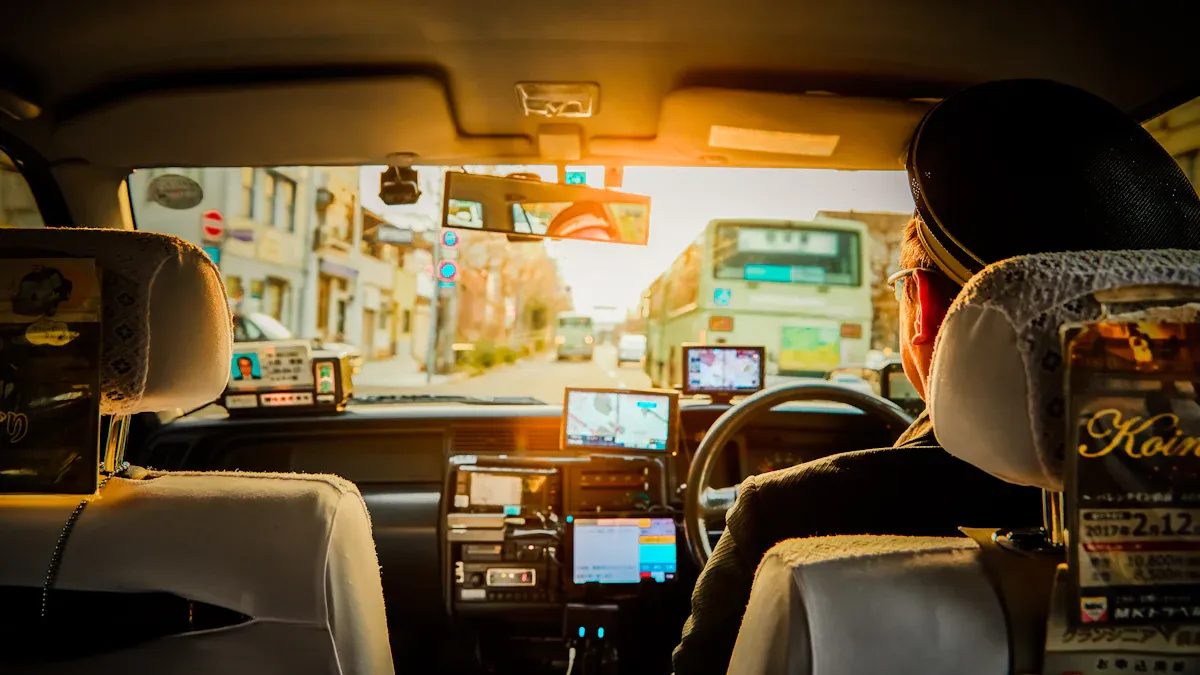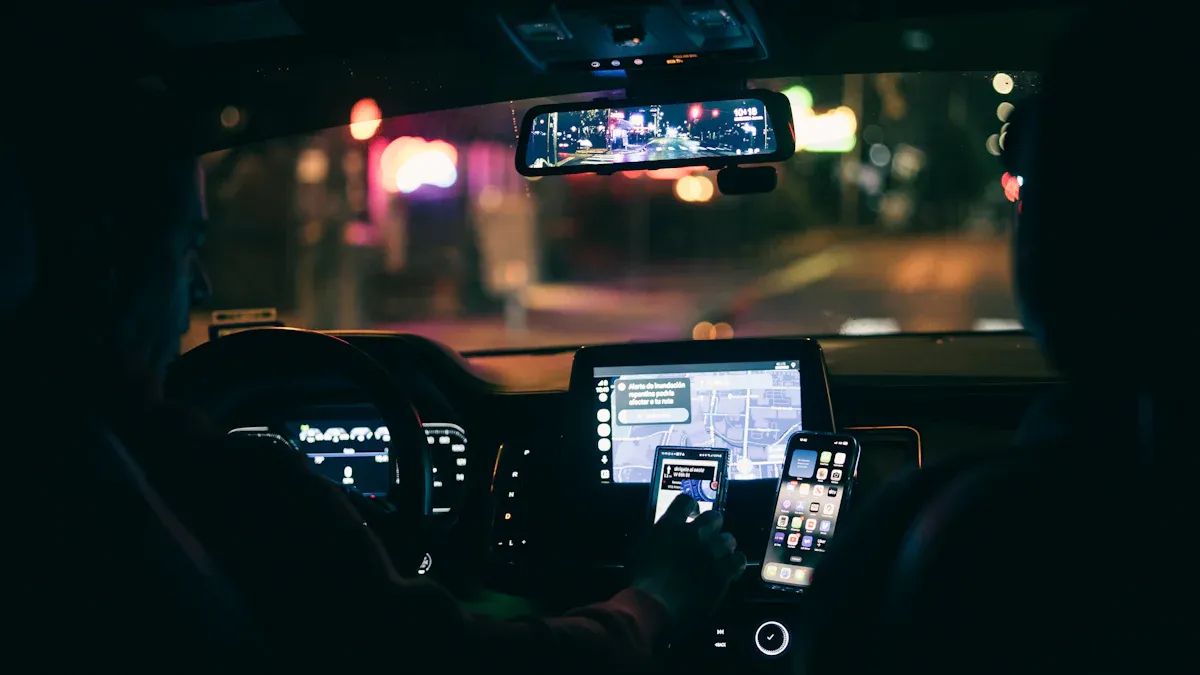
GPS-targeted taxi ads in Almaty use smart tools to show ads by location. Companies use taxi ads to reach people moving around the city. In Almaty, taxi ads often show up on screens inside taxis and on LED signs on top of cars. These tools help companies share ads with riders at the best place and time. GPS-targeted taxi ads in Almaty help companies reach people and give riders helpful info during their trip.
Key Takeaways
GPS-targeted taxi ads in Almaty use GPS to show ads. The ads match where the taxi is. This makes the ads more useful and on time. These ads show up on screens inside taxis. They also show on bright LED signs on top of taxis. This way, both riders and people outside see the ads. Advertisers can pick busy places to show their ads. They can change ads fast and see how well they work right away. Passengers see local ads during their ride. These ads tell them about shops, events, and deals nearby. GPS-targeted taxi ads are better than old ads. They target people better, update fast, and give good reports. This saves money and helps ads work better.
GPS-Targeted Taxi Ads in Almaty

What They Are
GPS-targeted taxi ads in Almaty use smart tools to show messages by where people are. Taxi ads often use screens inside the car or LED signs on top. These tools help companies reach people as they move around Almaty. The system uses GPS to know where the taxi is going. When the taxi goes into a new area, the ads change for that place. This is called location-based marketing. It helps companies show the right ad to the right people at the right time.
Taxi ads in Almaty are special because they use geo-targeted ads. These ads only show up when the taxi is near places like malls or business areas. Companies can pick which places they want to target. This makes gps-targeted taxi ads in Almaty good for reaching local people.
Key Features
GPS-targeted taxi ads in Almaty have some important features:
Real-time targeting: The system changes ads based on where the taxi is.
Flexible location targeting: Advertisers can choose certain areas or neighborhoods.
Multiple display options: Taxi ads use both screens inside and LED signs on top.
High visibility: People inside and outside the taxi can see the ads.
Data-driven results: Companies can see how many people saw their ads and which places worked best.
Note: Location-based marketing and geo-targeted ads help companies use their money well. They reach people who might want their products.
Taxi ads in Almaty use smart targeting so each ad fits the place and people. This helps companies get better results from their ads.
How It Works

GPS and Location Targeting
GPS helps taxis know where they are in Almaty. The system tracks each taxi as it moves around the city. When a taxi goes into a new area, the system notices the change. The media player inside the taxi then shows ads for that place. For example, if the taxi is near a mall, the screens can show ads for stores in that mall. When the taxi leaves, the ads go back to normal.
This uses geo-targeting and real-time geo-targeting to match ads to the location. Advertisers pick zones and choose which ads show in each one. The platform lets companies change their ads quickly and easily. Mobile location targeting helps brands reach people who may visit their business. This way, location-based marketing works better and saves money.
Note: GPS-powered ads in taxis help companies send the right message at the right time. Mobile location targeting lets them reach people as they travel.
In-Car Monitors and LED Displays
Dynamic taxi ads in Almaty use two main screen types. These are in-car monitors and car top LED displays. Each screen helps target both riders and people outside.
Taxi top LED displays sit on the car roof. These screens are bright and easy to see in sunlight. They show ads to people walking or driving by. The displays are strong and can handle city weather.
In-car monitors are on the headrests. They show ads right to the passengers. These screens use mobile location targeting to match the taxi’s area.
Advertisers use a content management system to make and plan ads. The CMS sends ads wirelessly to each taxi. The system can update ads in real time, based on where the taxi goes.
Onboard controllers change the screen’s brightness and contrast. LED modules work together to make clear, colorful images.
Cloud-based platforms let advertisers manage things from anywhere. They can change schedules, update ads, and check how ads are doing.
GPS modules help with location-based marketing by showing ads in certain areas. Time-based scheduling lets the system show different ads at different times.
The system supports many ad types, like taxi top, inside, and rear window displays. This helps more people see the ads.
The displays save energy and use strong materials. This makes them last longer and work well in any weather.
Tip: Mobile location targeting and location-based marketing help advertisers reach the right people. The technology keeps ads new and interesting.
Advertiser Process
Targeting Locations and Audiences
Advertisers in Almaty follow steps to reach the right people. First, they pick places where taxis go a lot. These places are busy streets, shopping centers, and business areas. They want their ads seen by many people.
Advertisers choose busy spots to get more views.
They use real-time geo-targeting to match ads to the taxi’s spot.
They look at old campaign data to make ads better.
Mobile location targeting helps them reach people near certain places. With geo-targeting, companies can focus on neighborhoods or landmarks. This way, ads reach the right people at the right time.
Tip: Advertisers check old campaign data to change their plans and get better results.
Designing and Uploading Ads
After picking places and targets, advertisers make their ads. They design ads for screens inside taxis or on top of cars. The ads must be clear and easy to read. Advertisers use pictures, short videos, or simple words to get attention.
When ads are ready, advertisers upload them to a content management system. This system sends ads to taxis all over Almaty. The platform lets advertisers update ads fast by place or time.
Tracking Results
Advertisers watch how their ads do using data from the taxi ad platform. They see how many people saw the ads in each place. The system gives reports on which places and plans worked best. Mobile location targeting tools help check if people liked the ads.
Advertisers use this info to make future ads better. They focus on places and ways that work best.
Benefits and Impact
For Advertisers
GPS-targeted taxi ads help advertisers reach people in Almaty. These ads use real-time data to show messages by where the taxi is. Advertisers can choose certain neighborhoods or busy streets. This helps them reach the right people at the right time. The system lets companies change ads fast if they want a new spot. Advertisers save money because they do not show ads to people outside their target area. Reports from the platform show which places work best. This helps companies make their ads better and get good results.
Tip: Advertisers can try different ads in each place to see what works best.
For Passengers
Passengers see ads that match where they are right now. This makes the ads more helpful and fun. For example, a rider near a mall might see deals for stores in that mall. Passengers can learn about events, restaurants, or services while riding. The ads can help people find new places to visit in Almaty. Many riders like seeing information that fits their needs during the trip.
Passengers get local deals and news.
Ads can help riders find new shops or events.
The content feels more personal and timely.
Compared to Traditional Ads
Traditional ads like billboards stay in one spot. They show the same message to everyone all the time. GPS-targeted taxi ads change with the taxi’s route and location. This means the ads reach people who care about them most. Advertisers can update their messages quickly, but billboards take more time and money to change. Taxi ads also give detailed reports, so companies know which places work best.
Feature | GPS-Targeted Taxi Ads | Traditional Ads |
|---|---|---|
Changes by location | ✅ | ❌ |
Real-time updates | ✅ | ❌ |
Detailed reports | ✅ | ❌ |
Fixed in one place | ❌ | ✅ |
Note: GPS-targeted taxi ads give more choices and better targeting than traditional ads.
Local Insights
Regulations
Taxi ads in Almaty must follow city laws. City leaders make rules for screens and LED signs on taxis. These rules help keep drivers and walkers safe. Taxi companies must check that their ads do not break copyright or patent rules. Sometimes, legal fights can stop a company from working. For example, G-Taxi once stopped Yandex.Taxi in Kazakhstan because of a patent fight about an automatic taxi order system. This kind of problem can make it hard for new companies to start. Taxi ad companies must watch for new laws to avoid fines or being shut down.
Market Trends
The taxi ad market in Almaty is getting bigger. More companies use screens inside taxis and LED signs on top to reach people. Advertisers like these tools because they can target certain places. They can show ads to people in some neighborhoods or near busy spots. Many brands use data to pick the best places for ads. Digital payments and mobile apps also help the market grow. Some companies try new ways to make ads more personal, like using rider data or showing local deals. The market is moving to smarter and more flexible ads.
Challenges
Taxi ad companies in Almaty have many problems. It is hard to find and keep good drivers. Some drivers need special training to give better service and change old habits. Picking the right phone system is not easy. Most drivers use Android, but many riders have iPhones. Safety checks, car checks, and following rules take time and money. Payment systems can be hard because not everyone uses cards. Companies often need to take both cash and cards. Riders want clear prices, but many do not get how meters work. People still like to wave down taxis, which makes it harder for apps to grow. Fights over ideas, like the one between G-Taxi and Yandex.Taxi, add more risk and worry. Companies must fix these problems to stay strong and reach local people.
GPS-targeted taxi ads in Almaty use smart tools to find people in the right spot. Advertisers can send messages to people nearby and check how well the ads do. Passengers see useful ads at the right time during their ride. This way gives more control and better targeting than old ads.
If you want to know more, you can talk to local taxi ad companies or look up digital out-of-home ads online.
FAQ
How do GPS-targeted taxi ads know which ad to show?
The system uses GPS to find where the taxi is. When the taxi moves to a new place, the ad changes. This helps show the best message for that area.
Can advertisers change their ads quickly?
Yes. Advertisers use a digital platform to upload new ads. They can update ads right away. This helps keep messages new and on time.
Are GPS-targeted taxi ads safe for drivers and passengers?
City rules say screens and displays must be safe. Taxi companies follow these rules to keep everyone safe. The screens do not block the driver’s view or bother riders.
Who sees the ads on taxi top LED displays?
People walking or driving near the taxi see the LED ads. These displays show ads to many people outside, not just riders inside.
What types of businesses use GPS-targeted taxi ads?
Many businesses use these ads. Stores, restaurants, event planners, and local services pick taxi ads to reach people in certain places.
See Also
Best GPS Units for Motorcycles Featuring CarPlay And Android Auto
Best CarPlay Adapter Options for VW Golf Drivers In 2025
Leading Wireless Android Auto Adapters For Audi Vehicles 2025
Guide To Using Thermal Imaging Cameras For Rescue Missions 2025
Understanding Wireless CarPlay Adapters And Enhancing Your Driving
